This post comes from Ecoscenography
Expanded scenography is everywhere. On the streets, in hospitals, at airports, parks and shopping malls and most recently, in the form of knitted pink beanies and protest banners at political rallies. Space ‘performs’ in the everyday, quotidian, and the mundane, providing much inspiration for scenographers both in and beyond conventional theatre. While it could be argued that ‘expanded scenography’ has existed since the beginning of human culture, performance design’s focus on the ‘expanded’ over the last decade has opened up new approaches and artistic insights. Gone are the days when being a stage designer was restricted to ‘working on other people’s shows’ in traditional theatre spaces. Instead, scenography now represents an exciting pathway for imagining and inspiring new realities beyond the confines of the theatrebuilding and its (often elite) audiences (Beer, 2017).
I recently had the pleasure of editing the newest edition of the CSPA Quarterly on ‘Expanded Scenography’ with fellow ecological artists Ian Garrett and Meghan Moe Beticks. Expanded Scenography is an emerging area in the field of stage design that is being increasingly embraced.  But what is it? ‘Scenography’ is already a contested term, with multiple definitions, but essentially one that describes the art of creating performance environments. Since the last half of the 20th Century, the term ‘scenography’ has rapidly replaced ‘stage design’, ‘theatre design’ or ‘set design’ in contemporary performance scholarship, and now represents a progressive field that is moving far beyond traditional scenic illustration and naturalistic representation.
 I use the term ‘expanded scenography’ to acknowledge an increasing number of performance designers working outside of traditional theatre, and whose passion for socio-ecological issues is at the core of their practice. Expanded scenography uses scenographic strategies (i.e. spatial, narrative, dramaturgical, performative and multi-sensory) as a way of engaging with the world beyond the theatre. I like to think of expanded scenography as stage design that ‘has left the building’ to intersect with daily life. The idea of scenography ‘leaving the building’ can be both literal and metaphoical, but the central premise is one of questioning normative practices and re-imagining what scenography is and what it can become. It is not bound to the schackles of theatre buildings, disciplinary rhetoric and formal expectations. Here, the scenographer is seen as both a designer and artist in their own right (as well as a producer, facilitator and instigator of creative work).
I use the term ‘expanded scenography’ to acknowledge an increasing number of performance designers working outside of traditional theatre, and whose passion for socio-ecological issues is at the core of their practice. Expanded scenography uses scenographic strategies (i.e. spatial, narrative, dramaturgical, performative and multi-sensory) as a way of engaging with the world beyond the theatre. I like to think of expanded scenography as stage design that ‘has left the building’ to intersect with daily life. The idea of scenography ‘leaving the building’ can be both literal and metaphoical, but the central premise is one of questioning normative practices and re-imagining what scenography is and what it can become. It is not bound to the schackles of theatre buildings, disciplinary rhetoric and formal expectations. Here, the scenographer is seen as both a designer and artist in their own right (as well as a producer, facilitator and instigator of creative work).
Ecoscenography works across both in expanded scenography and ecoscenography, but it is in the ‘expanded’ realm that I am finding myself the most these days. Perhaps, it is because the ‘expanded’ allows me to be free to explore the possibilities of ecoscenography — to create new ways of working that integrate ecological thinking without the constraints of unsustainable conventions of the mainstream. For example, projects like The Living Stage and This is not Rubbish could be described as ecoscenography within the realm of expanded scenography.
I hope that one day I can also create ecoscenographic designs in more traditional settings. I want to demonstrate that ecological projects can also take place in the beautiful theatres that first inspired me as a young artist. Regardless of whether designers want to work across conventional or more expanded contexts, one thing is clear: opportunities for performance designers have never been more diverse and inspiring. I look forward to seeing more scenographers using their theatre training to explore the potential to expand their practice outside of traditional contexts in the coming years.
Our special issue on ‘Expanded Scenography’ features artists who have ventured outside of the more traditional boundaries of theatre-making and performance design to find their own way of responding to the complex problems that haunt us in today. While incredibly diverse, it is our collaborative desire for contributing to the wider world and being part of the political debate as artists in our own right that unites us in this issue. We hope that this publication opens up discussions that reframe traditional perceptions of scenography and introduces new audiences to its potential. The full journal edition can be accessed here.
More information about Expanded Scenography can be found here.
The post, On Expanded Scenography, appeared first on Ecoscenography.
About EthnoScenography:
Ecoscenography.com has been instigated by designer Tanja Beer – a PhD candidate at the University of Melbourne, Australia, investigating the application of ecological design principles to theatre.
Tanja Beer is a researcher and practitioner in ecological design for performance and the creator of The Living Stage – an ecoscenographic work that combines stage design, permaculture and community engagement to create recyclable, biodegradable and edible performance spaces. Tanja has more than 15 years professional experience, including creating over 50 designs for a variety of theatre companies and festivals in Australia (Sydney Opera House, Melbourne International Arts Festival, Queensland Theatre Company, Melbourne Theatre Company, Arts Centre) and overseas (including projects in Vienna, London, Cardiff and Tokyo).
Since 2011, Tanja has been investigating sustainable practices in the theatre. International projects have included a 2011 Asialink Residency (Australia Council for the Arts) with the Tokyo Institute of Technology and a residency with the Royal Central School of Speech and Drama (London) funded by a Norman Macgeorge Scholarship from the University of Melbourne. In 2013, Tanja worked as “activist-in-residence†at Julie’s Bicycle (London), and featured her work at the 2013 World Stage Design Congress (Cardiff)
Tanja has a Masters in Stage Design (KUG, Austria), a Graduate Diploma in Performance Making (VCA, Australia) and is currently a PhD candidate at the University of Melbourne where she also teaches subjects in Design Research, Scenography and Climate Change. A passionate teacher and facilitator, Tanja has been invited as a guest lecturer and speaker at performing arts schools and events in Australia, Canada, the USA and UK. Her design work has been featured in The Age and The Guardian and can be viewed at www.tanjabeer.com





 The ephemeral and highly specific nature of theatrical work means that most set and costume designs are only valued for the duration of the performance season (often a matter of days or weeks) before they are discarded. Designers are rarely contracted to consider the impact of their designs after opening night, or to build post-production possibilities into their creative processes. But does it need to be this way? Can the image of the skip as the final resting place of most theatrical designs instead be revised to find another endpoint where creativity and innovation can once again flourish? How might scenographers embrace cyclic rather than linear production processes to rethink the potential of art’s refuse?
The ephemeral and highly specific nature of theatrical work means that most set and costume designs are only valued for the duration of the performance season (often a matter of days or weeks) before they are discarded. Designers are rarely contracted to consider the impact of their designs after opening night, or to build post-production possibilities into their creative processes. But does it need to be this way? Can the image of the skip as the final resting place of most theatrical designs instead be revised to find another endpoint where creativity and innovation can once again flourish? How might scenographers embrace cyclic rather than linear production processes to rethink the potential of art’s refuse?



 Refugium considers how highly visual, sensorial, interactive and participatory events can catalyse engagement, cultivate empathy, precipitate action and engender regenerative potential. Through the work, I ask: (i) How can we engage audiences to reveal urban nature, and provoke humanities intrinsic emotional connection with nature?; (ii) How can artistic practices deliver ecological understanding of environmental adaption and resilience?, and; (iii) How can artistic practices reveal pathways for community involvement in environmental stewardship and cultivate hope for the future?’.
Refugium considers how highly visual, sensorial, interactive and participatory events can catalyse engagement, cultivate empathy, precipitate action and engender regenerative potential. Through the work, I ask: (i) How can we engage audiences to reveal urban nature, and provoke humanities intrinsic emotional connection with nature?; (ii) How can artistic practices deliver ecological understanding of environmental adaption and resilience?, and; (iii) How can artistic practices reveal pathways for community involvement in environmental stewardship and cultivate hope for the future?’.
 In the UK Summer of 2015, I collaborated with local theatre company Eco Drama to create a travelling garden with and for children that could brighten up Glasgow’s concrete playgrounds; fusing live performance with living plants.
In the UK Summer of 2015, I collaborated with local theatre company Eco Drama to create a travelling garden with and for children that could brighten up Glasgow’s concrete playgrounds; fusing live performance with living plants. The project involved working with four Glasgow primary schools to design, grow and build a portable stage. I joined permaculturist Katie Lambert and the pupils in their concrete playgrounds in late Spring to plant out quirky containers with basil, parsley, tomatoes and carrots. Despite the dreary Glaswegian weather, the children’s enthusiasm to be outside and get their hands dirty was infectious – placing their hands into the soil was regularly met with audible ‘aahs’ and ‘ooohhs’. Even in pouring rain, there was an instinctive desire for the children to engage with the world beyond the classroom walls.
The project involved working with four Glasgow primary schools to design, grow and build a portable stage. I joined permaculturist Katie Lambert and the pupils in their concrete playgrounds in late Spring to plant out quirky containers with basil, parsley, tomatoes and carrots. Despite the dreary Glaswegian weather, the children’s enthusiasm to be outside and get their hands dirty was infectious – placing their hands into the soil was regularly met with audible ‘aahs’ and ‘ooohhs’. Even in pouring rain, there was an instinctive desire for the children to engage with the world beyond the classroom walls.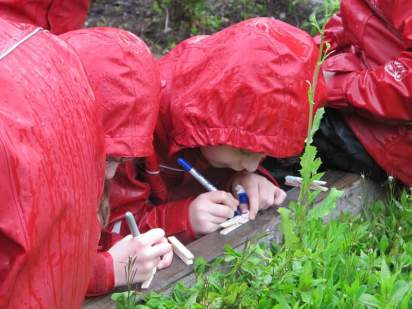
 Through the growing season, the director, performers and I began building a show around the budding plants, coupling storytelling with experiences of gardening. The story that emerged followed three characters (Plum, Lily and Basil) singing to the salads, flowers and herbs amongst their curious home of plants. Told through music, movement and multi-sensory storytelling, Uprooted connected audiences with nature through the view of the wider planet as home. In true Living Stage spirit, Uprooted became part theatre show, part garden and part installation, where audiences had the opportunity to nibble at the stage and sample drinks made from the set.
Through the growing season, the director, performers and I began building a show around the budding plants, coupling storytelling with experiences of gardening. The story that emerged followed three characters (Plum, Lily and Basil) singing to the salads, flowers and herbs amongst their curious home of plants. Told through music, movement and multi-sensory storytelling, Uprooted connected audiences with nature through the view of the wider planet as home. In true Living Stage spirit, Uprooted became part theatre show, part garden and part installation, where audiences had the opportunity to nibble at the stage and sample drinks made from the set.
 Uprooted toured to various outdoor venues and schools across Glasgow, before finding its way back to the schools that helped plant it. As the students returned from their school holidays, they watched the performance and were excited to see how much their plants had grown. They were amazed at how the plump vegetables, bushy herbs and soaring sunflowers that inhabited the set had emerged from the tiny seeds that they had planted months ago. The students revelled in tasting unusual herbs and flowers, and embraced new textures, flavours and sensations. I have never seen so many children so excited about a zucchini. But more broadly, they also shared an immense pride in the space and the fact that ‘their’ stage had been touring around their home city.
Uprooted toured to various outdoor venues and schools across Glasgow, before finding its way back to the schools that helped plant it. As the students returned from their school holidays, they watched the performance and were excited to see how much their plants had grown. They were amazed at how the plump vegetables, bushy herbs and soaring sunflowers that inhabited the set had emerged from the tiny seeds that they had planted months ago. The students revelled in tasting unusual herbs and flowers, and embraced new textures, flavours and sensations. I have never seen so many children so excited about a zucchini. But more broadly, they also shared an immense pride in the space and the fact that ‘their’ stage had been touring around their home city.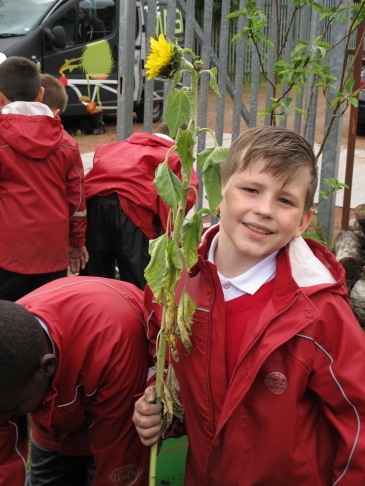 As the children returned to their classrooms after the final session of planting, Eco Drama’s director Emily Reid pulled me aside. She had seen how a boy had taken the initiative to claim responsibility for a sunflower he had planted during the transplanting of the set – even giving the flower its own name ‘Jack’. Emily saw the boy standing by one of the garden beds and started walking towards him, when she suddenly stopped, intrigued.
As the children returned to their classrooms after the final session of planting, Eco Drama’s director Emily Reid pulled me aside. She had seen how a boy had taken the initiative to claim responsibility for a sunflower he had planted during the transplanting of the set – even giving the flower its own name ‘Jack’. Emily saw the boy standing by one of the garden beds and started walking towards him, when she suddenly stopped, intrigued. This boy had found a way to break through perceived binaries between humans and nature, nature and culture. He had connected to the ecological complexity of the living world with such simplicity. In this moment of more-than-human communication, this small boy had seen himself as an integral part of the web of life, as though it was the most natural thing in the world.
This boy had found a way to break through perceived binaries between humans and nature, nature and culture. He had connected to the ecological complexity of the living world with such simplicity. In this moment of more-than-human communication, this small boy had seen himself as an integral part of the web of life, as though it was the most natural thing in the world.
 Bømlo Teater is an amateur theatre on a relatively small municipally on the west-coast of Norway.  There are 12,000 inhabitants located on a labyrinth of 1007 big and small islands. With a wide horizon stretching out beyond the land, the locals are immensely proud of this place they call home. Many of the inhabitants work offshore, as part of the oil-industry or farming Salmon (delivering 10% of the world market). As well as a booming economic market, the west coast has a thriving cultural scene, with three theatres, including Northern Europe’s largest outdoor amphitheatre. It is here that I find myself working amongst lots of half-crazy, creative people committed to making art and theatre.
Bømlo Teater is an amateur theatre on a relatively small municipally on the west-coast of Norway.  There are 12,000 inhabitants located on a labyrinth of 1007 big and small islands. With a wide horizon stretching out beyond the land, the locals are immensely proud of this place they call home. Many of the inhabitants work offshore, as part of the oil-industry or farming Salmon (delivering 10% of the world market). As well as a booming economic market, the west coast has a thriving cultural scene, with three theatres, including Northern Europe’s largest outdoor amphitheatre. It is here that I find myself working amongst lots of half-crazy, creative people committed to making art and theatre.
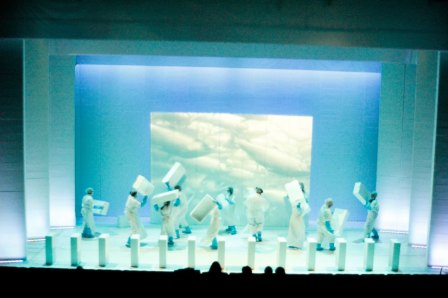 I was interested in expressing a sense of monotony with the Styrofoam – the institutionalised cleanliness of a food-factory in a massive scale while at the same time, maintaining a sense of poetry. I did this by making walls out of piles of 950 Styrofoam crates that I sourced at a factory only 2km away from the theatre. While it was very simple, when placed together the multitude of boxes had a lovely effect – perfect for the lighting-designer to play with, and for projecting video. 50 of crates were also used on stage by the actors as changeable items (e.g. chairs, beds, TVs, the assembly-line).
I was interested in expressing a sense of monotony with the Styrofoam – the institutionalised cleanliness of a food-factory in a massive scale while at the same time, maintaining a sense of poetry. I did this by making walls out of piles of 950 Styrofoam crates that I sourced at a factory only 2km away from the theatre. While it was very simple, when placed together the multitude of boxes had a lovely effect – perfect for the lighting-designer to play with, and for projecting video. 50 of crates were also used on stage by the actors as changeable items (e.g. chairs, beds, TVs, the assembly-line). To assist with the poetic feel, we collaborated with a local salmon-factory, who provided us with live film footage inside one of the fish-cages. With the music going, it looked like the salmon was dancing along with the actors, in their own ballet!  Another local salmon factory gave us the white overalls. They were pre-used so all we had to do was to cover their logo on the back.
To assist with the poetic feel, we collaborated with a local salmon-factory, who provided us with live film footage inside one of the fish-cages. With the music going, it looked like the salmon was dancing along with the actors, in their own ballet! Â Another local salmon factory gave us the white overalls. They were pre-used so all we had to do was to cover their logo on the back.
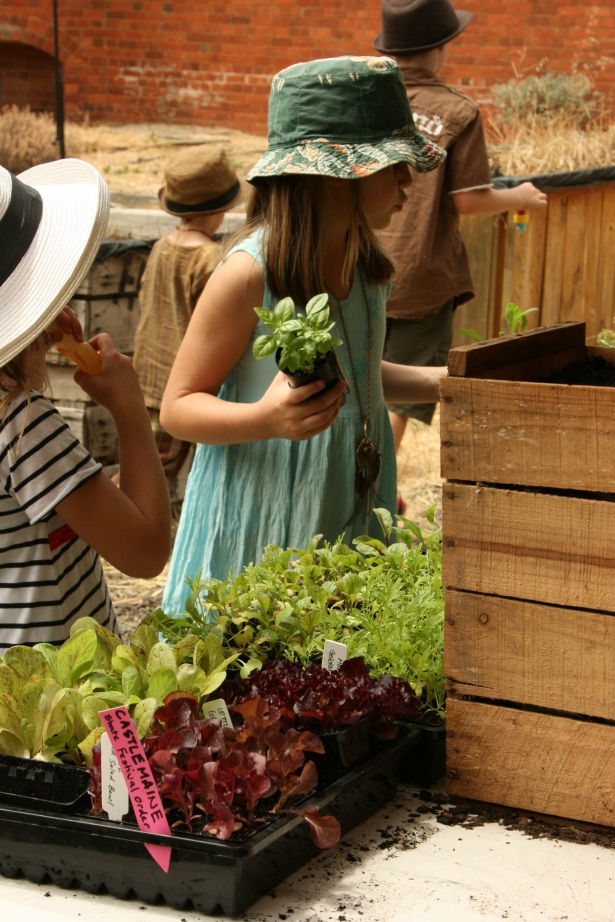 As the deadline of handing in my PhD draws closer, I’m excited about uncovering the potential of Ecoscenography. Here, I share a short summary of my research and the possibilities of contributive practice in the performing arts.Â
As the deadline of handing in my PhD draws closer, I’m excited about uncovering the potential of Ecoscenography. Here, I share a short summary of my research and the possibilities of contributive practice in the performing arts. 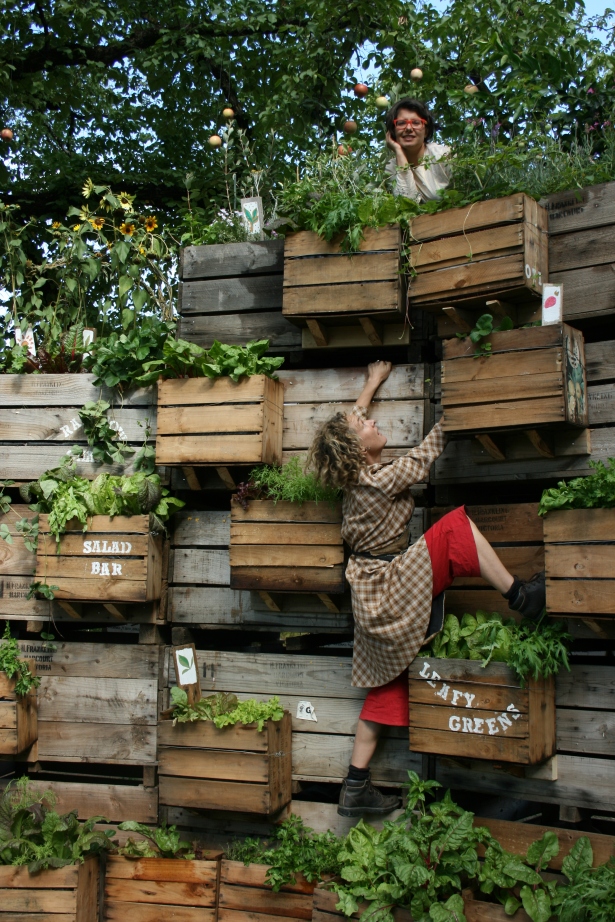 Since starting my candidature, a selection of my creative works have developed under the banner of The Living Stage – a global project that combines stage design, permaculture and community engagement to create recyclable, biodegradable and edible performance spaces. Part theatre, part garden and part food growing demonstration, The Living Stage considers ecological principles and environmental impact as opportunities rather than constraints: ethics that can illuminate, and be integral to aesthetics. At the end of the performances, my living stages are returned to the communities that helped grow them. Physical structures become garden beds and community spaces; plants become healthy food; and waste becomes compost. As each living stage evolves out of a direct response to the localities of site, ecology and community, no project is ever the same.
Since starting my candidature, a selection of my creative works have developed under the banner of The Living Stage – a global project that combines stage design, permaculture and community engagement to create recyclable, biodegradable and edible performance spaces. Part theatre, part garden and part food growing demonstration, The Living Stage considers ecological principles and environmental impact as opportunities rather than constraints: ethics that can illuminate, and be integral to aesthetics. At the end of the performances, my living stages are returned to the communities that helped grow them. Physical structures become garden beds and community spaces; plants become healthy food; and waste becomes compost. As each living stage evolves out of a direct response to the localities of site, ecology and community, no project is ever the same.
 Loosely based on Jules Verne’s epic adventure, Journey to the Centre of the Earth, starting in Iceland, three ‘wunderkind’ Geo-Scientists (Flavia Bertum, Ayesha Tansey and Sabrina Manach) from ‘MyGeoCorpse Mining Corporation’ set off in search of precious minerals. As they drill down through the earth’s layers their machinery breaks down, finding themselves lost in the darkness. As panic ensues, they continue on foot, delving deeper into the collective unconscious they begin to unearth the complexities of climate change.
Loosely based on Jules Verne’s epic adventure, Journey to the Centre of the Earth, starting in Iceland, three ‘wunderkind’ Geo-Scientists (Flavia Bertum, Ayesha Tansey and Sabrina Manach) from ‘MyGeoCorpse Mining Corporation’ set off in search of precious minerals. As they drill down through the earth’s layers their machinery breaks down, finding themselves lost in the darkness. As panic ensues, they continue on foot, delving deeper into the collective unconscious they begin to unearth the complexities of climate change.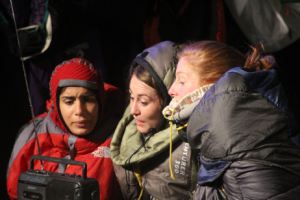 It is worth noting that camping equipment is made from synthetic textiles such as nylon, polyester and ripstop derived from the petro-chemical industries (which will take between 20 and 200 years to biodegrade). A sleeping bag is composed of three layers: outer shell (synthetic material), filing (feather or synthetic), lining (synthetic, fleece, silk or cotton), zips – (aluminum, metals, plastic), toggles and cord (plastic and cotton) and polyester sewing thread. It is estimated that 45,000 tents are brought to Reading Festival with 13,500 abandoned at the end of the weekend. The cost of tents (£20) and sleeping bags (£10) has been cited as one of the causes and has changed the nature of camping from a ‘once in a life-time’ purchase to a throw away item.
It is worth noting that camping equipment is made from synthetic textiles such as nylon, polyester and ripstop derived from the petro-chemical industries (which will take between 20 and 200 years to biodegrade). A sleeping bag is composed of three layers: outer shell (synthetic material), filing (feather or synthetic), lining (synthetic, fleece, silk or cotton), zips – (aluminum, metals, plastic), toggles and cord (plastic and cotton) and polyester sewing thread. It is estimated that 45,000 tents are brought to Reading Festival with 13,500 abandoned at the end of the weekend. The cost of tents (£20) and sleeping bags (£10) has been cited as one of the causes and has changed the nature of camping from a ‘once in a life-time’ purchase to a throw away item.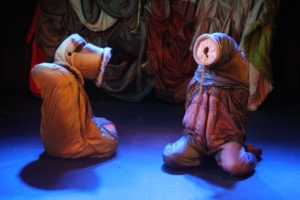 The good news is that Reading Festival in collaborative partnership with Julie’s Bicycle,
The good news is that Reading Festival in collaborative partnership with Julie’s Bicycle,  I believe that there is nothing that can give you a deeper appreciation of the resources that go into the production of an item than mindfully deconstructing it. Initiatives and ‘tear downs’ run by places such as FabLab, Hackerspaces, Makersspaces and Restart are great teachers of this process. Once you have experienced this (which I highly recommend!), it becomes increasing difficult to relegate things to the scrap heap. It is a highly insightful process.
I believe that there is nothing that can give you a deeper appreciation of the resources that go into the production of an item than mindfully deconstructing it. Initiatives and ‘tear downs’ run by places such as FabLab, Hackerspaces, Makersspaces and Restart are great teachers of this process. Once you have experienced this (which I highly recommend!), it becomes increasing difficult to relegate things to the scrap heap. It is a highly insightful process.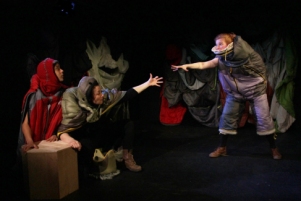 My journey has just begun with HOAX and there will be lots more scope for exciting ecological and creative solutions to inspire the next stages of the design. A work-in-progress presentation of Journey to the Centre of the Earth took place at the Pleasance Theatre, London in October 2015 (as part of ArtCOP21) where I also shared this story as part of a post-show Q&A. The show was a great success, paving the way for a full-length production planned for 2016. My costume also had another outing (worn by Flavia Bertum) at the
My journey has just begun with HOAX and there will be lots more scope for exciting ecological and creative solutions to inspire the next stages of the design. A work-in-progress presentation of Journey to the Centre of the Earth took place at the Pleasance Theatre, London in October 2015 (as part of ArtCOP21) where I also shared this story as part of a post-show Q&A. The show was a great success, paving the way for a full-length production planned for 2016. My costume also had another outing (worn by Flavia Bertum) at the 